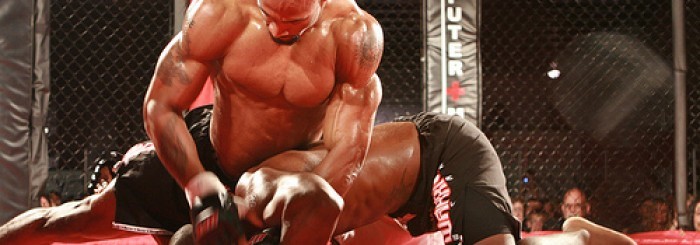
Get Fight Fit with these MMA Conditioning Exercises
Every child of the 80’s and 90’s loves the idea of being a Wushu Warrior, Kung Fu Master or a Muay Thai specialist. But if the recent rise in MMA has taught us anything it is this; all the fancy spinning kicks in the world mean nothing without conditioning.
In the close-quartered combat of a tight Bangkok street Steven Seagal may be able to use his attackers weight against them and provide deadly blows. But how would Mr Seagal fair in The Octagon where athleticism and conditioning become as important as skill?

Our guess? Not well, not well at all.
Conditioning, known to the common man as “how fit the lad is” is a highly important factor in the sphere of MMA so much so that athletes spend a vast majority of their training taking part in speed work, road work (running) and a whole host of other MMA conditioning exercises.
Though a number of standardised rules exist and a select number of fighting styles dominate the octagon, the original concept is that any one person could have a background in any martial art. As such, the skill level can be exceptionally varied and any one fight could have any outcome. This is what makes MMA such an appealing sport and what makes conditioning just as important as skill.
Though we at PhysioRoom.com would love to be able to explain how to become a Kung Fu Master or a 10th Dan in Karate in a few hundred words, alas we in fact cannot – shocking huh?
What we can do however is give you a list of the Top 8 MMA Conditioning Exercises to fast track your fitness and dance around the octagon. Which is exactly what we have done.
Forget heavy squats and deadlifts, the majority of strength training needs to be based on body weight. This does not mean that weight lifting doesn’t have its place, it’s just not a central activity. Remember; the goal is the goal – if you want to be a power lifter, lift heavy things – if you want to be a fighter, train like one.
Burpees
Never has an exercise hurt as much as the Burpee. It is the all-encompassing full body blast from hell that will knock you on your derriere and leave you there. In short, it’s just about the best body weight exercise one can do, and here’s how:
- From a standing position with shoulder width at the legs perform a simple squat.
- Next kick the legs back and form a plank position with the legs apart.
- Return the legs to the centre and squat back up.
- Jump up from the squat. Repeat.
To make the exercise harder, place either a push up or extended reach after point 2 or perform tuck jumps, squat thrusts or pull ups to make the exercise even more brutal. The key is to maintain perfect form whilst gassing the hell out.
https://www.youtube.com/watch?v=O7_TBHno0Os
Marine Push Up
The common push up is an exercise mainstay and has been since Eugene Sandow’s influx of Physical Culture in the 1800’s. Though a lot may have changed in 100 years, one thing that hasn’t is that push ups, are hard. The Marine Push Up is a mainstay in the U.S Marine Corps and focuses on proper form and regimented movements. Drop and give me 10:
- Starting in a regular push up position, place the hands directly under the shoulders and lower the chest slowly to the floor.
- Marines start at the bottom, so keep the abdominals tight and lift the chest quickly to the top of the movement and lower slowly. Optional shout of “Marine Corps”at the top.
Easy right? Not so fast. Marines count press ups in a movement of four; lift, lower, lift, lower – that’s one. Try doing 50, sorry, 100. Lowering slowly works the eccentric muscles the triceps and shoulders whilst the concentric contraction remains sharp to attack the chest.
https://www.youtube.com/watch?v=69Vv4arfABw
Shadow Boxing
You may feel a bit daft bouncing around the mat not actually punching anything but shadow boxing, specifically with heavy gloves is a great way to practice form and execution whilst training the body’s anaerobic system and fast twitch muscle fibers. The heavier the gloves the more exertion is placed on the upper body muscles. An MMA or boxing gym equipped with room sized mirrors and mats is best for shadow boxing but realistically, it can be done anywhere.
- From your regular fight stance practice a few taught combinations.
- Intertwine rest periods with bursts of push ups, sit ups, burpees and other body weight exercises.
- Mix up the tempo round by round with focus on slow movements for perfect technique and all out lung busting for speed and power.
https://www.youtube.com/watch?v=oXvQUtpZBs0
Stair Sprints
Remember Rocky’s famous sprint up the steps of the Philadelphia Museum of Modern Art? That wasn’t an accident. Step running is one of the most important aspects of all fight training. When you are forced to run up stairs, your body reacts in a different way to simply running on the road as the leg muscles are working against a resistance. This increase in demand causes contractions in the major muscle groups and pushes the body into an anaerobic state which is far more beneficial for the fast pace of the octagon.[4] Using a heart rate monitor or workout tracker can be of massive benefit.
- Starting slow keep the heart rate as low as possible to warm up with.
- Slowly start to bring the arms into the equation and pump with the fists.
- Increasing the speed, attack a set of stairs in a number of rounds; 5 steps fast, 5 steps recovery, 5 steps fast. This will aid reaction time and keep your heart rate guessing.
- When running down the steps again, keep the abdominals tight and back straight. The impact of the steps will provide a core workout and ample recovery.
Advancing from here you may wish to try two steps at a time or even squat jumps – just remember to recover properly in between rounds – you will get tired, if you’re not you must be Superman.
https://www.youtube.com/watch?v=veFULT3b2_0
Kettlebells
These pseudo-Russian kettle like weights have been popping up everywhere recently, and for good reason. As the weight is extended beyond the point of the hand, the kettlebell provides an exceptionally functional ballistic set of movements that require a great amount of core strength to control. Their uneven and sometimes unpredictable movements are hugely useful to the sport of MMA due to the nature of balance, core strength and skill required. Perhaps the best form of functional movement with kettlebells is the swing which is a fantastic exercise for upper body, lower body and core strength.
- From a squatting position, take the kettlebell in an overhand grip in between the legs.
- Thrust upwards as if performing the upward phase of a squat.
- Upon reaching full back extension perform a single front raise with the kettlebell. The other hand can be placed either at the side or in the small of the back for balance.
- Raise the kettlebell until the body is at full extension and the weight is fully above the head – however do not lock the arms.
- Slowly lower the kettlebell and begin the squat once the kettlebell is slightly lower than chest height.
The trick is combining the above into a single fluid movement of fast up and slow down. Make it more difficult by increasing the weight and swapping hands each time.
https://www.youtube.com/watch?v=0_XjJjLc7NE
Jumping Rope
Yes it’s true, once more Rocky had it down and rope jumping, also known in the mind of a 5 year old as skipping, is a fantastic cardiovascular strength exercise that is commonly associated with boxing and MMA. Rope jumping helps to build an incredible endurance base in a low impact setting whilst also focusing on building the shoulders, chest and calves whilst developing the core muscles and spine. PhysioRoom.com stocks a number of ropes including the PhysioRoom.com Speed Skipping Rope for beginners and the Fitness Mad Pro Leather Jump Rope for the more advanced user.
- With a light rope focus primary on the technique and building an endurance base. Aim for rounds of 3-5 minutes in length.
- Using a heavier rope will help to increase flexibility and power in the upper body.
- Ankle weights can also be worn to increase the resistance on the calves and create a solid bounce that is highly beneficial to quick movements and reactions in the octagon.
Advanced workouts can include double jumps, alternate foot-steps, side swings and even backward swings. Again aim for rounds of 3-5 minutes and increase the pace and intensity by adding resistance in the rope.
https://www.youtube.com/watch?v=vKxnhxI3q6Y
Heavy Bag Work
Ever wondered how MMA fighters manage to kick each other for rounds at a time without seemingly feeling a thing (Anderson Silva aside)? Two words; limb conditioning. Though it may not look like much, the constant kicking, punching, elbows and knees on a heavy bag is the perfect way to harden the elements most likely used in an attack and in defence. Kicking the heavy bag causes the shins to develop micro-fractures and calcification which harden the area over time. This process also occurs in the forearms, knees and even knuckles so get pounding those heavy bags. Just leave banana trees to Buakaw.
- Start by focusing on form, performing soft perfectly executed kicks on the bag.
- Utilise rounds to focus on kicks alone but stay light enough to be able to perform the motion over and over.
- Building up to full power is a process that takes months and though it may be tempting to boot the bag as hard as you can – it will only leave you unable to walk the next day.
Mix things up by focusing separately on the various elements of your stand up routine before having a full contact round to finish things off.
https://www.youtube.com/watch?v=tnnsfQdUZ9w
HIIT
Though technically High Intensity Interval Training (HIIT) can be performed more or less anywhere and with any equipment, the most common way to blast your V02 Max is by using a stationary bike. When HIIT is performed correctly it results in a heavy energy output and can lead to injury should one be performing an activity that is high in impact such as running or even bag work. The idea of HIIT is to create an environment whereby the heart rate is forced to rise and fall sharply and as such sprinting is the common way to manipulate the heart in this fashion. Yet sprinting, especially on a hard surface can be destructive to the knees when executed poorly. As such, many HIIT enthusiasts utilise the freedom of a stationary bike such as the BH Fitness Duke Magnetic Bike which features ergonomic handling and triathlon bars for optimum positioning.
- Start with the bike on an easy spin cadence around 80-100 RPM for 5 minutes.
- Pyramid up the exertion level by increasing the intensity for a set amount of time before returning to the easy spin for a period of time again.
- Do this again but climb up another level for a shorter amount of time before returning back to square one.
Whilst easy spinning it is exceptionally important that one tries to get the heart rate to return to as low a figure as possible. Breath in long and deep and if you can, wear a heart rate monitor to focus your attention properly.

